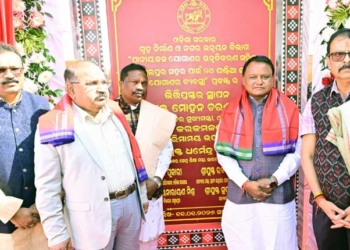Balasore: As night falls over Nilagiri in Balasore district, a strange and dramatic scene unfolds. People rush into the streets, only to scatter moments later in fear. A man, with blood-red vermilion on his forehead and a sharp axe in hand, charges through the crowd. But this is not a scene from a horror film—this is Bali Khela, a unique ritual held during Durga Puja that reenacts ancient human sacrifices in a symbolic way.
The Bali Khela ritual is deeply tied to the worship of Maa Kanakdurga, the royal goddess of the Nilagiri kingdom. According to history and local legends, this tradition dates back to the 12th century, when human sacrifices were offered to the goddess during the midnight of Durga Ashtami.
Today, the practice no longer involves real sacrifices. Instead, the ritual has taken a symbolic and theatrical form. But the fear and excitement it generates among people remain strong.
Who is the Bali Nayak?
Every year, a man is chosen to become the Bali Nayak—the “sacrificial leader” and representative of the goddess. For 16 days, he lives a life of devotion and ritual discipline.
At midnight, he emerges from the Jagannath Temple of Nilagiri, considered the “third Srikhetra” of Odisha. With a ritual axe (Tangia) in hand and a white cloth over his shoulders, he charges through the Grand Road of Nilagiri, terrifying the crowd.
According to folklore, anyone touched by the Bali Nayak was once believed to die mysteriously within days. While no one believes that anymore, the fear and thrill of being chased remain part of the experience.
Historical records reveal that actual human sacrifices were once part of this ritual. But major reforms began during 1871–1874, when Fakir Mohan Senapati served as Dewan (chief) of Nilagiri.
Working with King Krishna Chandra Mardraj Harichandan, Senapati convinced the British authorities to stop human sacrifices. As a compromise, monkeys were sacrificed instead.
Later, between 1921 and 1960, under King Kishore Chandra Mardraj Harichandan, the ritual continued with animal sacrifices like buffaloes and goats. Finally, under the last king, Rajendra Chandra Mardraj Harichandan, these were also stopped. Now, only gourds (Pani Kakharu) are used as symbolic offerings.
However, the ‘Bali Khela’ at the Nilagiri Jagannath Temple begins four days before the Sasthi Puja — the day when the Kalisi (God man) touches a person from the gathering, who then sacrifices a gourd during the Ashtami Puja. Originally, the ritual lasted for 16 days, which was later reduced to 10 days, and now to 5.
Each night, the Bali Nayak runs through the streets at midnight. People from nearby districts like Mayurbhanj and Bhadrak gather in large numbers to witness this unique mix of tradition, drama, and fear.
Though the ritual is no longer deadly, it still holds deep emotional and spiritual meaning for locals. Those “touched” by the Bali Nayak symbolically offer gourds at the Kanakdurga Temple on Ashtami night.
Despite changes over the years and the banning of animal sacrifices, the spirit of the ritual remains strong. The Bali Nayak still carries his axe. Drums still beat. Flames still flicker in the night. And people still run—not out of fear of death, but to be part of a living tradition that connects them to their ancestors, their goddess, and their unique cultural identity.
With Dussehra celebrations in full swing, Nilagiri transforms into a place where myth, history, and modernity meet in a hauntingly beautiful ritual—Bali Khela.

















